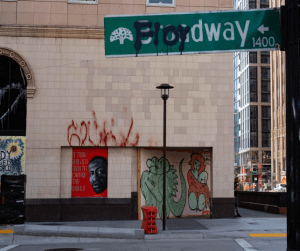Pedro Lange-Churión and John Zarobell
On Tuesday, April 20, 2021, Derek Chauvin was convicted of murdering George Floyd and the public has seen, at long last, that our justice system is capable of prosecuting and punishing police officers who brutalize black and brown bodies. This decision can in no way reconcile the injustices faced by minorities in this country. Indeed, during the trial, it was reported that on average three people of color per day are killed by police officers in the United States. This story is not resolved but the protests against police violence that took place over the summer of 2020 and the civil disorder that resulted have also reignited a creative legacy of protest art that has been a key element of social protest movements around the world and in the Bay Area.
This piece, a collaboration between us, was an effort to capture the political divides in this country as they emerge on the contested streets of Oakland. The rifts left by Donald Trump’s efforts to drag the country away from any social progress we might have achieved over the last 100 or so years frames both, the civil unrest and our efforts to read it through the renegade public art that materialized in the very center of the city. We aimed to create a dialectic between images and texts about the city, about racial politics, and about the revolutionary efforts to demand rights for all people and to assert, above all, that Black Lives Matter.
Here is an excerpt from the article:
Floydway

You had such a vision of the street As the street hardly understands —T.S. Eliot, Preludes
*
This renaming to Floydway marks the street as a site of trauma. Floyd himself looks on. It is a moment of discontinuity that generates a new symbolic, an intervention against the reality of the power and violence of the state, manifested in the planning and maintenance of the city. Rancière calls this dissensus, this break in consciousness that emerges from the rewriting of the street in the name of those subverted by it. The subversive laughter brings out an unintended response to the city as it is.
Citation and link to the full article:
Lange-Churión, Pedro, and John Zarobell. “Report from Oakland: The Art of Insurrection.” Theory & Event 23, no. 5 (2020): S-110-S-126. muse.jhu.edu/article/775406.